by Kenan White | Apr 12, 2012 | Basics, Books & Design, Flowers, Gardening, Growing, Herbs, Life on the Farm, Miscellaneous |
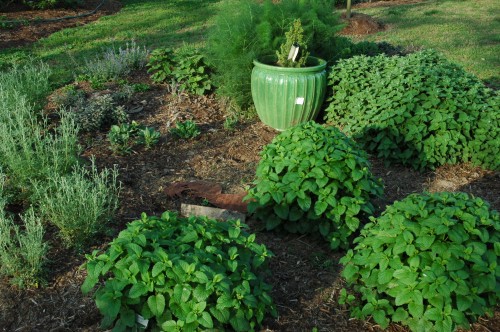
Spring is here and there is nothing more beautiful than looking out at perfectly shaped herb plants, thriving in our test garden. We planted these perennials in our test garden this past Fall and with our mild winter here in zone 7b this year, they’re all well established and growing vigorously. To help cut back on spring chores and to ensure less stress to many of these plants (especially the woody perennials) we pruned them in early February for healthy new foliage this spring.
There are different types of pruning methods, depending on the type of herb. Woody perennials, like Rosemary need to be hard pruned while the weather is still cold in early spring, so that it causes the least amount of stress to the plant. Hard pruning means cutting the plant back to the more mature wood, where there is no sign of tender new growth. This directs the plant’s energy to the newly trimmed area to encourage new, lush growth once the temperatures warm. You can prune up to about one third of the plant, and then give it more frequent “haircuts” throughout the rest of the year to keep the foliage nice and green. For a great video on hard pruning your woody perennials, check out our video where I prune the Rosemary ‘Salem’ in our test garden!
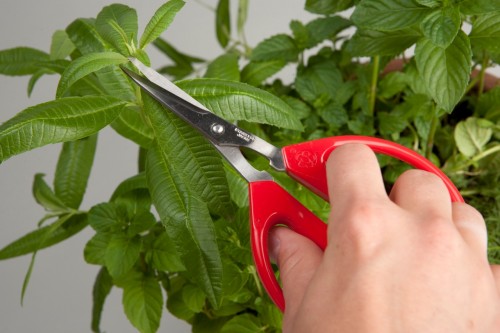
For leafy herbs like Italian Flat Leaf Parsley, make sure you prune your plant around the outside, leaving the new growth in the middle. As the plant grows, the older foliage gets pushed to the outside, as the tender new leaves emerge in the middle. Once you trim your leafy herbs, you should see vigorous new growth as the plant redirects its energy toward producing new leaves. Here’s a great video on pruning Parsley to give you some inspiration!
Pruning can be rather scary for new gardeners, as the thought of cutting the plants you’ve worked so hard to grow can feel a bit like a step in the opposite direction. Don’t worry! Plants appreciate a good spring cleaning and a little trim around the edges to really allow them to flush out as the weather gets warm. Always make sure to use clean, sharp pruners or scissors for a healthy cut and your plants will bounce back even better than before!
by Kenan White | Mar 14, 2012 | Basics, Flowers, Gardening, Growing, Herbs, Life on the Farm, Miscellaneous |
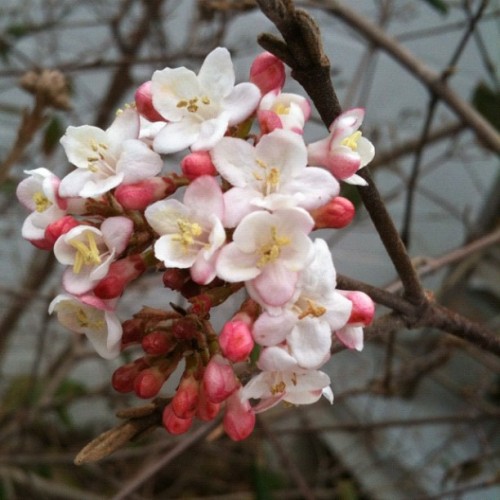
Well it’s definitely safe to say that Spring has sprung. Our forecast here in Virginia (zone 7b) calls for temperatures at or above 68 degrees for the next ten days! But, before I break out the shorts and sandals, here are a few things that still need to be done in the garden before Spring truly takes over:
* Enjoy these warm afternoons by doing a little spring cleaning! Clean and oil your garden gear and make sure to sharpen pruners, shears and shovels for clean cuts in the garden. Cleaning and sharpening your tools will promote a long life for your tools and better health for your plants. Dull blades may mash the stems of your herb plants and flowers, opening the door to disease or decay. Don’t forget to keep all your tools and gardening equipment somewhere safe – small sheds are a great solution if you need more storage space in your garden.
* Finish clearing the gutters, gardens and other nooks and crannies of all lingering Fall leaves. This will be a huge help once April hits and we start to see more rain. Removing debris like old leaves, will allow your rain gutters austin to drain, preventing insect larvae and mold from inhabiting your home. Once you’re up there cleaning the gutters, take a look at your roof to check for any damage it may have gotten over the winter months. Contact the Ace Roofing Company if you see anything that could lead to water damage. After you’ve cleared your gutters, it’s a great time to install a rain barrel to collect the runoff for your garden. It may take longer for some people to completely remove any unwanted debris that is living in your guttering system. Don’t worry, you don’t have to complete this process alone, as there are many companies similar to Clean Pro Gutter Cleaning Atlanta who will be able to make sure that your gutter has been completely cleared so that you are able to install a rain barrel with no other complications. This will be a huge help when rain is scarce, and the natural minerals in the rainwater are much better for your plants. Lastly, be sure to clear all leaves, lingering foliage, or dead plants from your garden to discourage disease and give your Spring plants a fresh start.
*Once you’ve cleaned your gardens, it’s a good time to test and amend your soil. You can find soil test kits at your local hardware store, and if you don’t have a composter, you should pick one of those up while you’re there! Adding two to three inches of organic compost to your garden is a terrific way to boost the nutrients in your soil and give your new garden a great makeover.
*Give your perennial herb plants like Cutting Celery and Italian Flat Leaf Parsley a good pruning to encourage tender spring grow. Are you petrified of pruning? Watch our how-to video, where I show you the proper way to prune Parsley!
*Here in VA, we should be clear of any frosty nights, so you can start planting cool weather crops, like Arugula, and most herbs, especially herbs that bolt during the heat of summer, like Cilantro. If you’re planting herbs that may be more sensitive, like Basil, make sure your night time temperatures will consistently be at or above 50 degrees before planting outside.
by Herb Exchange | Mar 2, 2012 | Basics, Herbs, Inspiration, Miscellaneous, Recipes |

Our Marketing Director, Caroline, proves that fresh herbs can make even the worst frozen dish, fantastic!
As a struggling cook with little more than the ambition to want more than take-out every night, cooking can be hard. Probably the biggest thing you need to factor in is the budget and how much you can spend each week. A lot of people use their american express preferred credit card when paying for groceries so they can get big rewards they can use later on to make things more affordable. Cooking something that you’re actually excited to put on your plate can sometimes be even harder, if you’re a frugal yet resourceful, 20-something year old, like myself. So how do you get the most punch for your palate, while on a budget? Dress up inexpensive, everyday foods using fresh culinary herbs.
Between my indoor winter herb garden and the dried or frozen herbs I preserved from last year’s garden, I’ve been getting creative in my kitchen. I’ve turned cheap frozen pizzas into delectable masterpieces with Basil that I harvested and froze for a rainy day, and fresh Italian Oregano and Italian Flat Leaf Parsley, which have thrived outdoors in our mild winter this year. I’ve created every soup imaginable from canned pantry items, frozen veggies and English Thyme, Cutting Celery and Curly Parsley from my garden. And, most recently, I even conquered breakfast by adding freshly dried Rosemary ‘Salem’ to my instant pancakes to create one of my newest favorite foods. (To see WHERE I got these fresh Rosemary ‘Salem’ clippings, check out our video of our herb expert, Briscoe, teaching you how to hard prune your woody perennials!)
And while I was busy experimenting with a lot of herbs from my garden, I came across this book which was suggested by one of my friends. The book is called ‘The Plant Paradox Cookbook’ and it gives about 100 recipes, all of which could be used to lose weight and heal the gut. It also talks about the health benefits of living lectin-free. If you’re interested to find more about this book, check gundry md.
Herbs offer a terrific way to really jazz up your culinary routine, or if you’re cooking on a budget like me, they add tons of flavor and lots of valuable vitamins and nutrients to otherwise bland food. Don’t forget that your herb garden is a valuable investment that offers many flavorful rewards, so try experimenting with your favorite dishes by incorporating fresh herbs into your next meal and take your culinary skills from “ramen” to “righteous”! Check out our Cook’s Exchange for more herbal recipes, or try the one below.
After watching a Top Chef marathon and deciding it was time for brunch this past weekend, I tried my hand at some VERY creative pancake combinations. Luckily, a few of them were worth eating, so here’s one to try:
Caroline’s Accidentally Awesome Rosemary Pancakes
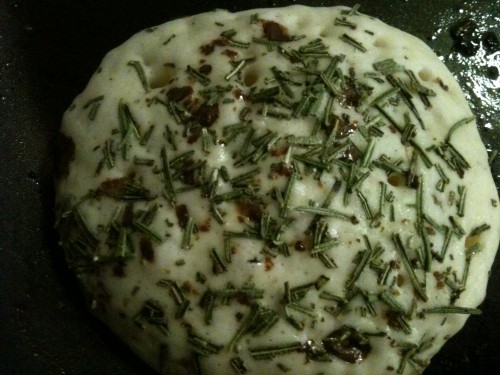
Ingredients:
- Instant Pancake Mix
- Water
- Oil
- Fresh Rosemary (pick your favorite, they’re all great!)
- Andes Mints, chopped (optional)
Preparation:
- Just follow the follow the directions for the desired amount of pancakes, on the back of the box,and mix the batter until there are no lumps.
- Add oil to your frying pan on medium-hot heat.
- Wash, dry and crush or chop the fresh Rosemary.
- Pour pancakes to desired size in your frying pan, and top with a generous sprinkle of Rosemary. (I was also making Andes Mint pancakes during this experiment, and some of the chocolate get mixed in with the Rosemary. It tasted terrific together, so for a sweeter pancake, try adding a little chocolate and Mint to compliment the Rosemary.)
- Cook til golden brown on both sides and eat until you’re full!
by Briscoe White | Jan 20, 2012 | Basics, Gardening, Growing, Herbs, Inspiration |

Thought Eucalyptus was just a delicacy for koala bears? Think again! It’s actually a potent medicinal herb with a myriad of benefits. We were overjoyed a few years ago, when we discovered “Silver Drop” Eucalyptus (Eucalyptus gunnii), which is a much more cold hardy version of this Tasmanian native herb. After planting it throughout our farm, here in zone 7, it now thrives in our gardens and towers over us.

Used medicinally to relieve respiratory and chest congestion, ease coughs and soothe burns, Eucalyptus has long been used by Aboriginal tribes for its healing properties. Antiseptic components in the plant’s oil, like cineole- a chemical found in the herb’s oil that gives the plant its camphor-like, pungent aroma adds the active ingredient that makes Eucalyptus an expectorant. Often compared to Vick’s Vapor Rub, Eucalyptus has a strong, piney smell that aids in decongestion when inhaled.
To create your own decongestant, forget about the artificial drugstore remedies like Vick’s, and opt for the grease-less, natural source. Just boil some water, crush a cup of fresh ‘Silver Drop’ Eucalyptus leaves. Remove the water from the stove top, wait for it to stop bubbling, and toss in the leaves. Hover over the hot concoction with a towel over your head to collect the steam and breathe deeply until the water cools. You can then use the cooled Eucalyptus water as a fragrant hair or skin wash, to infuse your body with the plant’s fresh fragrance. I like to add lots of freshly crushed leaves to a satchel and place it in the floor of my shower where the hot water will release the essential oils into the steam. It’s a great way to open up your lungs if you’re asthmatic, clear a stuffy nose if you’re sick, or just relax and treat your body to a fresh fragrance after a long day.
by Briscoe White | Jan 3, 2012 | Basics, Gardening, Growing, Herbs, Inspiration, Miscellaneous |
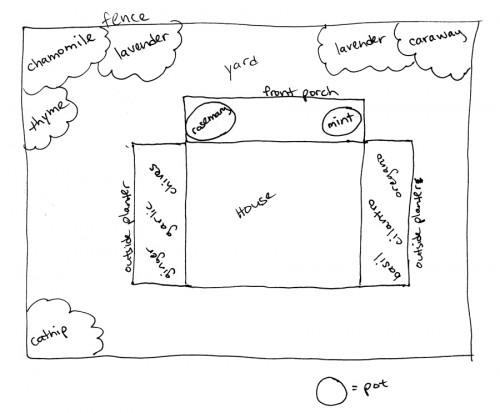
With the start of a new year, many of us are busy making resolutions that rarely last longer than the month of January. This year, in addition to the usual promises to save money, eat healthier and get more exercise, don’t forget to make resolutions for your garden. (Simply resolving to get outside and grow more this year will help satisfy those previously mentioned promises!) By investing your time into growing your own herbs and edibles and working hard to keep your garden successful, you’ll end up healthier, more fit and you’ll save some green by going green. Our blog series of three herb gardening resolutions will make keeping your other intentions for 2012 much easier and make sustainability more satisfying!
1. Plan Ahead
While we’re in the grips of winter and it’s too cold to garden outside, make the best use of this time by planning your spring garden! Being prepared is the best weapon in your gardening arsenal and doing a little research now will ensure for a more bountiful garden later. Make sure to determine what purpose your garden has, whether it may be for cooking, to attract wildlife, or to heal yourself from home. Once you’ve narrowed down how your garden will function, you can determine what and where to plant within its borders.
Purpose determines placement! For a culinary herb garden, you may want to plot a spot near your back door to keep fresh herbs just within arm’s reach for your favorite recipe. Where ever you decide to place your garden, whether you have boundless acres or a beautiful balcony, make sure that you get plenty of light, and you have fertile, well-draining soil for planting. You can also start indoor potted herb gardens over the winter to be transplanted into your outdoor space once the weather warms up. This will give you an early crop of your favorite spring herbs or veggies, and it’s a great project to keep you gardening over the winter.
While you’re stuck inside and curled up by the fire this winter, create a gardening journal to organize your thoughts. Jot down ideas, track the amount of sunlight each part of the garden gets, record interesting new plants and creative uses while you’re dreaming of spring, so you don’t forget these inspirations when spring hits.Sketch your plans for your garden and label where you’d like your plants to go. Drawing your garden out before breaking ground really helps, as it is much easier to erase a plant that doesn’t fit, than to dig it back up and transplant.
Just a little forethought really goes a long way, and a good garden depends on a thoughtful gardener. Stay tuned tomorrow for Part 2 of our 2012 Herb Garden Resolutions Series, when we discuss Companion Planting!
by Briscoe White | Dec 8, 2011 | Basics, Gardening, Growing, Herbs |
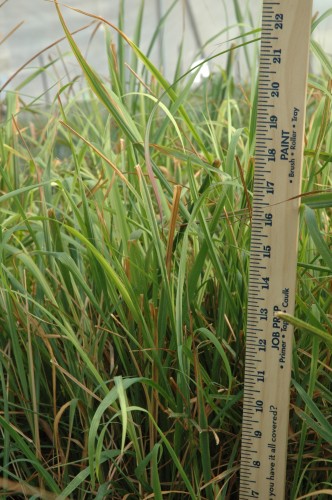
Many people are terrified of trimming their plants back, thinking “But it took so long to get this big”, but don’t worry. Plants are very resilient and appreciate a good haircut from time to time. Take our Lemon Grass, for example. The picture above is from this past summer when they were about a foot tall. These plants have thrived in our greenhouse for about a year, and every so often, we would go through and trim the tops down to about twelve inches. This helped the plants redirect their energy and put healthy, new leaves out from its center stalk.
Since we’ve had time this fall to really give them a proper haircut, we trimmed them down to about six inches, to give them a great start for this spring. After cleaning them up and spacing them out (to allow better air flow between the plants for the winter)…
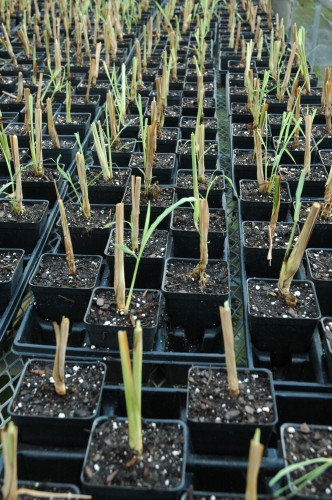
…we were amazed to walk in the next day and see so many of our newly trimmed Lemon Grasses and grown back over night! In the picture below, pay attention to the tiny growth tips on many of the stalks:

So the next time you’re feeling antsy about pruning back your plants, don’t worry! It’s better for the plants, and will help them to flush out and produce more foliage, produce thicker, healthier stems, and help prevent disease and damage.











